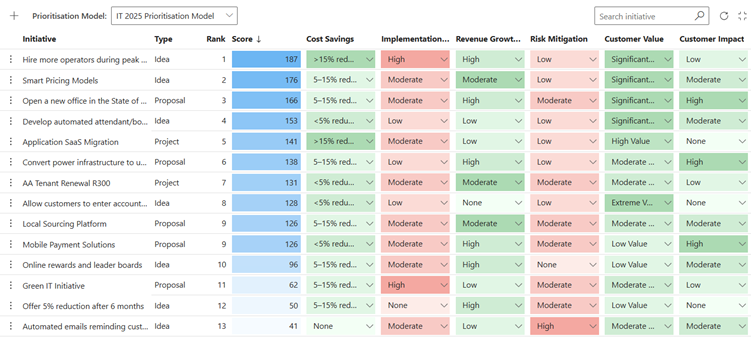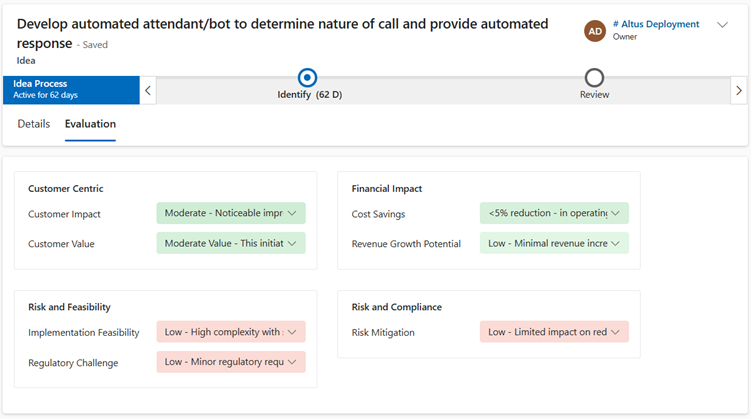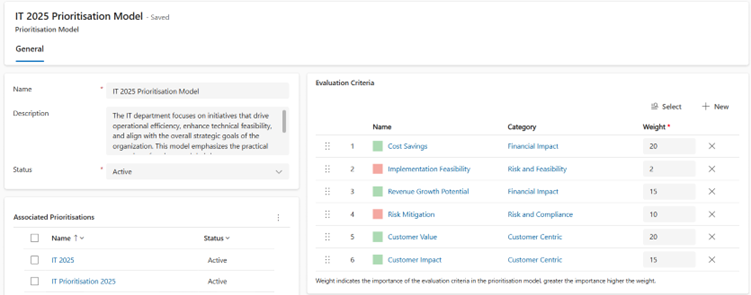Altus Prioritisation: Keep Projects Focused and Aligned to Strategic Goals
In a recent webinar hosted by Sensei, our senior project experts introduced the new Altus prioritisation feature, designed to help organisations assess and prioritise their initiatives against key organisational outcomes.
Built in Altus’ Strategy tier, Prioritisation aims to ensure that any types of initiative – projects, proposals, ideas – are not just progressing but are delivering better business outcomes by aligning them with strategic business priorities.
With hefty budgets allocated to projects every year and often more initiatives in the pipeline than can be delivered, data-driven, strategically aligned prioritisation keeps the organisational project agenda focused on the work that maximises value.
For PMO and Portfolio leaders, the new Prioritisation function supports critical and consistent evaluation of initiatives across the organisation.
How Altus Prioritisation works
The new Prioritisation system uses a weighted scoring model, allowing organisations to rate initiatives based on various weighted criteria such as strategic alignment, financial benefits, and risk.
By using a weighted scoring approach, Altus helps organisations prioritise the work that is most likely to provide the best return on investment. The system is flexible, allowing for different prioritisation models tailored to various departments or business units, ensuring that each can focus on its specific goals, aligned to organisational outcomes.
The new feature provides a clear and intuitive visualisation of prioritisation, making it easier for stakeholders to understand and engage with the prioritisation process.

Key Benefits of Altus Prioritisation
Alignment with Strategic Goals: Ensures all initiatives (ideas, proposals, projects) are aligned with the strategic goals of your organisation by evaluating them against customisable evaluation criteria.
Enhanced Decision-Making: Provides managers with a clear and quantifiable way to prioritise initiatives, facilitating informed discussions and decisions about which initiatives to pursue.
Flexibility and Customisation: Offers complete configurability, allowing your organisation to define and adjust evaluation criteria and prioritisation models to fit specific needs and strategic priorities.
Improved Resource Allocation: Helps in identifying the most critical initiatives, ensuring that resources are allocated efficiently to the projects that will deliver the highest value.
Transparency and Accountability: Promotes transparency by making the prioritisation process and evaluation criteria visible to all stakeholders, fostering accountability and buy-in from team members.
Streamlined Planning Process: Simplifies the planning process by providing a single view of all initiatives within a plan, allowing for easy evaluation, re-evaluation, and prioritisation.

Implementation and Use
Altus Prioritisation has been developed with customisation to an organisation’s unique requirements in mind, understanding that each one will have specific drivers and measures for project success:
- Set Up Your Organisation’s Criteria: Organisations can define and group criteria, such as customer-centric, financial, and risk-related criteria, and assign relative importance weightings to each. To suit your organisation’s size, structure and program/portfolio complexity, you can create multiple prioritisation models, using relevant criteria for each area.
- Conduct Evaluation: Initiatives are evaluated based on their contribution to these criteria, and the system calculates a prioritisation score that reflects both positive and negative impacts.
- Test and adjust criteria: As you and your teams become familiar with the Prioritisation model, you can adjust criteria and weightings to continuously refine initiative assessment, building data-driven, objective scores for all work.

Practical Applications
Altus Prioritisation is designed tohelp bridge the gap between strategy formulation and execution by providing leaders and executives with valuable, consistent assessment insights and a clear view of initiative alignment with strategic goals.
The benefits of this new capability work across the organisation:
- Investing in the right initiatives: It’s common to have a large number of initiatives that are all considered important and urgent by the people proposing them. The reality is the organisation may only have the budget for ten of them and resources for seven. By running each initiative through the Altus Prioritisation process you can ensure the most valuable initiatives contributing to organisational success are objectively identified. You can also refine the measures for “important” and “urgent” over time to continuously improve the value of your effort/initiative investments.
- Becoming more data-driven: Often you have a strong ‘gut feel’ that a project is important and needs to be done but require a more objective assessment of its value to the organisation. By assessing it against the agreed organisational Prioritisation measures you will have a clear view of its value, supporting the development of a successful business case that demonstrates this strategic alignment to key stakeholders.
- Empowering decision makers: We’ve all been in review meetings with senior leadership and had the question posed, “How did this project get up?!” With Altus Prioritisation, you now have the history and weighting scores to show how the decision was made, including alignment with the organisational strategic agenda.
In addition to Prioritisation, Altus enables the tracking of both the benefits and costs associated with projects, ensuring a comprehensive view of return on investment that is data-driven, resulting in greater confidence in the decisions made around projects, programs and portfolios of work.
By keeping records of previous prioritisation models and their outcomes, organisations can refine their prioritisation criteria and improve decision-making over time, supporting a process of continuous improvement and the delivery of higher value work.
Coming soon – Altus scenario modelling
Upcoming Altus Strategy features will build on Project Prioritisation with the inclusion of program & portfolio Optimisation. This introduces features that allow for scenario modelling, helping organisations plan and compare different portfolios and programs of work, further refining investment decisions.
Conclusion
Altus Prioritisation is a powerful tool for organisations looking to keep their initiatives focused and aligned with their strategic goals. By providing a flexible, transparent, and data-driven approach to prioritisation, Altus helps organisations make better decisions, track value effectively, and continuously improve their programs and portfolios.
Sensei is very happy to demonstrate the value of Altus prioritisation and answer any questions you may have. For more information, please get in touch. For more information, watch the webinar: On-demand: Keep your work focused and on track with the new Altus project prioritisation



